MERCEDES-BENZ CLK CABRIOLET 2000 A208 Owner's Manual
Manufacturer: MERCEDES-BENZ, Model Year: 2000, Model line: CLK CABRIOLET, Model: MERCEDES-BENZ CLK CABRIOLET 2000 A208Pages: 323, PDF Size: 9.32 MB
Page 161 of 323
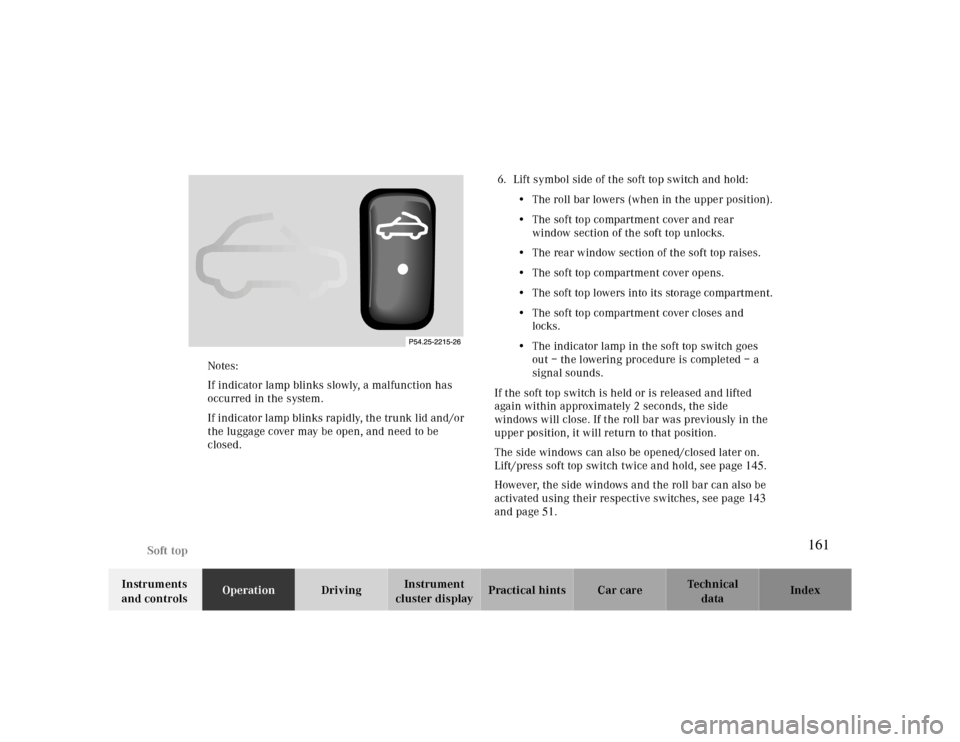
Soft top
Te ch n ica l
data Instruments
and controlsOperationDrivingInstrument
cluster displayPractical hints Car care Index Notes:
If indicator lamp blinks slowly, a malfunction has
occurred in the system.
If indicator lamp blinks rapidly, the trunk lid and/or
the luggage cover may be open, and need to be
closed.6. Lift symbol side of the soft top switch and hold:
•The roll bar lowers (when in the upper position).
•The soft top compartment cover and rear
window section of the soft top unlocks.
•The rear window section of the soft top raises.
•The soft top compartment cover opens.
•The soft top lowers into its storage compartment.
•The soft top compartment cover closes and
locks.
•The indicator lamp in the soft top switch goes
out – the lowering procedure is completed – a
signal sounds.
If the soft top switch is held or is released and lifted
again within approximately 2 seconds, the side
windows will close. If the roll bar was previously in the
upper position, it will return to that position.
The side windows can also be opened/closed later on.
Lift/press soft top switch twice and hold, see page145.
However, the side windows and the roll bar can also be
activated using their respective switches, see page143
and page51.
161
Page 162 of 323
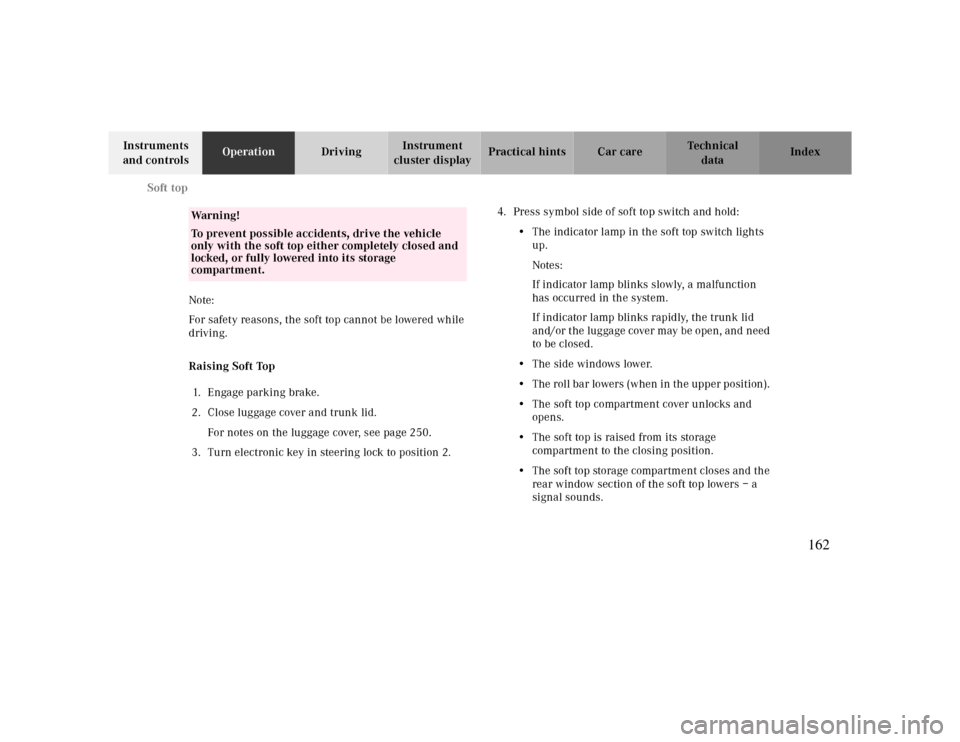
Soft top
Te ch n ica l
data Instruments
and controlsOperationDrivingInstrument
cluster displayPractical hints Car care Index
Note:
For safety reasons, the soft top cannot be lowered while
driving.
Raising Soft Top
1. Engage parking brake.
2. Close luggage cover and trunk lid.
For notes on the luggage cover, see page 250.
3. Turn electronic key in steering lock to position 2. 4. Press symbol side of soft top switch and hold:
•The indicator lamp in the soft top switch lights
up.
Notes:
If indicator lamp blinks slowly, a malfunction
has occurred in the system.
If indicator lamp blinks rapidly, the trunk lid
and/or the luggage cover may be open, and need
to be closed.
•The side windows lower.
•The roll bar lowers (when in the upper position).
•The soft top compartment cover unlocks and
opens.
•The soft top is raised from its storage
compartment to the closing position.
•The soft top storage compartment closes and the
rear window section of the soft top lowers – a
signal sounds.
Warning!
To prevent possible accidents, drive the vehicle
only with the soft top either completely closed and
locked, or fully lowered into its storage
compartment.
162
Page 163 of 323
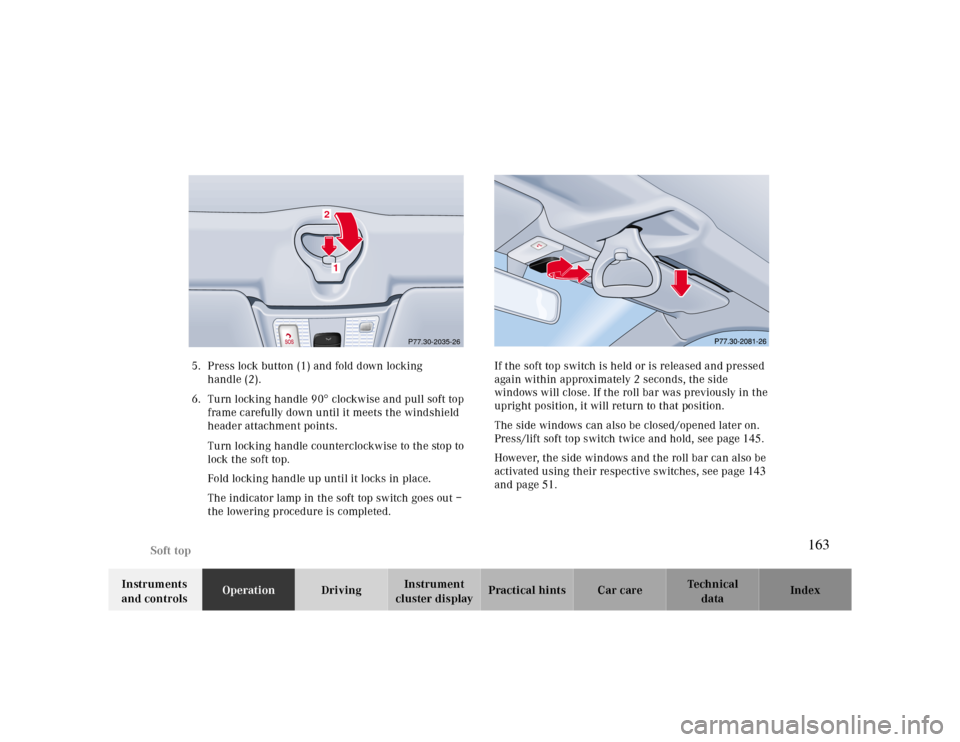
Soft top
Te ch n ica l
data Instruments
and controlsOperationDrivingInstrument
cluster displayPractical hints Car care Index 5. Press lock button (1) and fold down locking
handle (2).
6. Turn locking handle 90° clockwise and pull soft top
frame carefully down until it meets the windshield
header attachment points.
Turn locking handle counterclockwise to the stop to
lock the soft top.
Fold locking handle up until it locks in place.
The indicator lamp in the soft top switch goes out –
the lowering procedure is completed. If the soft top switch is held or is released and pressed
again within approximately 2 seconds, the side
windows will close. If the roll bar was previously in the
upright position, it will return to that position.
The side windows can also be closed/opened later on.
Press/lift soft top switch twice and hold, see page145.
However, the side windows and the roll bar can also be
activated using their respective switches, see page143
and page51.
P77.30-2035-26
12
163
Page 164 of 323
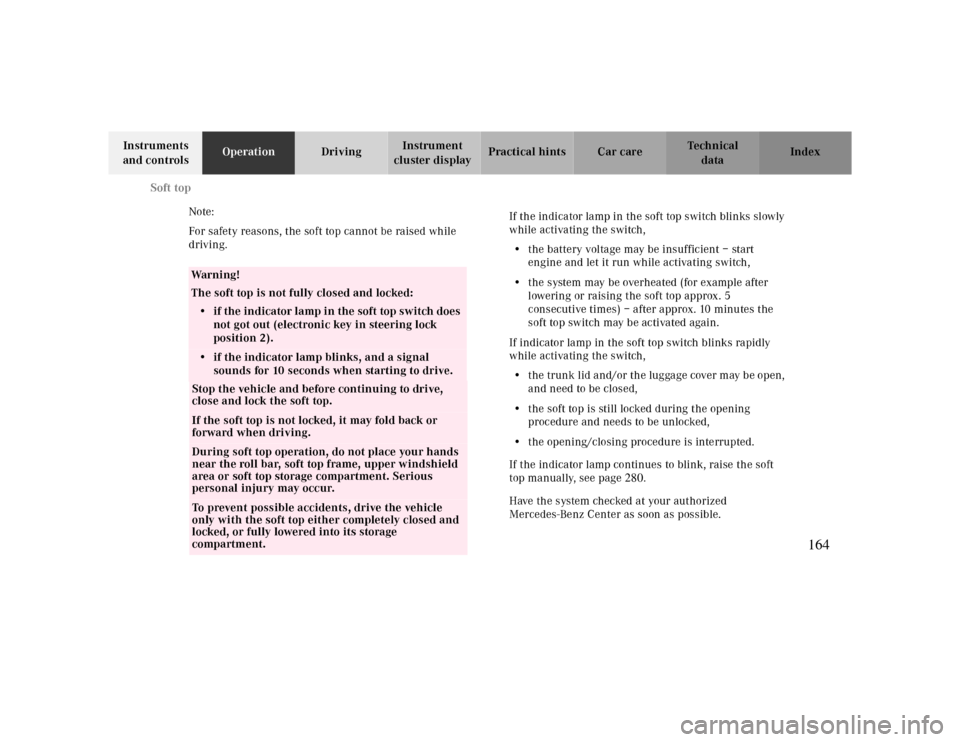
Soft top
Te ch n ica l
data Instruments
and controlsOperationDrivingInstrument
cluster displayPractical hints Car care Index
Note:
For safety reasons, the soft top cannot be raised while
driving.
Warning!
The soft top is not fully closed and locked:
• if the indicator lamp in the soft top switch does
not got out (electronic key in steering lock
position 2). • if the indicator lamp blinks, and a signal
sounds for 10 seconds when starting to drive. Stop the vehicle and before continuing to drive,
close and lock the soft top. If the soft top is not locked, it may fold back or
forward when driving. During soft top operation, do not place your hands
near the roll bar, soft top frame, upper windshield
area or soft top storage compartment. Serious
personal injury may occur. To prevent possible accidents, drive the vehicle
only with the soft top either completely closed and
locked, or fully lowered into its storage
compartment. If the indicator lamp in the soft top switch blinks slowly
while activating the switch,
•the battery voltage may be insufficient – start
engine and let it run while activating switch,
•the system may be overheated (for example after
lowering or raising the soft top approx. 5
consecutive times) – after approx. 10 minutes the
soft top switch may be activated again.
If indicator lamp in the soft top switch blinks rapidly
while activating the switch,
•the trunk lid and/or the luggage cover may be open,
and need to be closed,
•the soft top is still locked during the opening
procedure and needs to be unlocked,
•the opening/closing procedure is interrupted.
If the indicator lamp continues to blink, raise the soft
top manually, see page280.
Have the system checked at your authorized
Mercedes-Benz Center as soon as possible.
164
Page 165 of 323
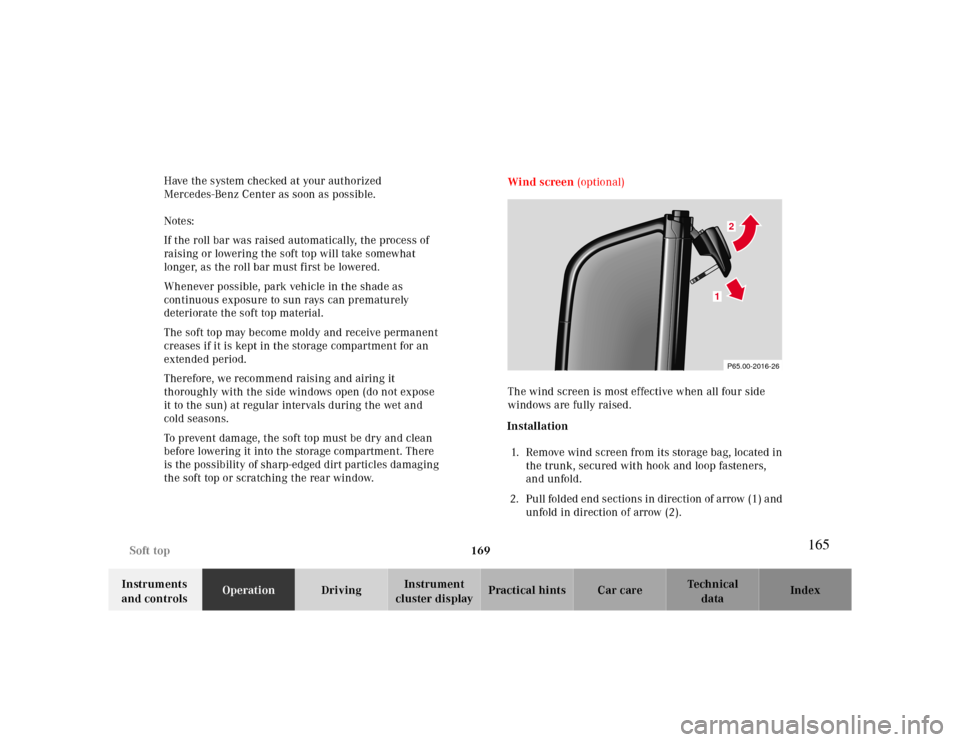
169 Soft top
Te ch n ica l
data Instruments
and controlsOperationDrivingInstrument
cluster displayPractical hints Car care Index Have the system checked at your authorized
Mercedes-Benz Center as soon as possible.
Notes:
If the roll bar was raised automatically, the process of
raising or lowering the soft top will take somewhat
longer, as the roll bar must first be lowered.
Whenever possible, park vehicle in the shade as
continuous exposure to sun rays can prematurely
deteriorate the soft top material.
The soft top may become moldy and receive permanent
creases if it is kept in the storage compartment for an
extended period.
Therefore, we recommend raising and airing it
thoroughly with the side windows open (do not expose
it to the sun) at regular intervals during the wet and
cold seasons.
To prevent damage, the soft top must be dry and clean
before lowering it into the storage compartment. There
is the possibility of sharp-edged dirt particles damaging
the soft top or scratching the rear window.Wind screen (optional)
The wind screen is most effective when all four side
windows are fully raised.
Installation
1. Remove wind screen from its storage bag, located in
the trunk, secured with hook and loop fasteners,
and unfold.
2. Pull folded end sections in direction of arrow (1) and
unfold in direction of arrow (2).
P65.00-2016-26
1
2
165
Page 166 of 323
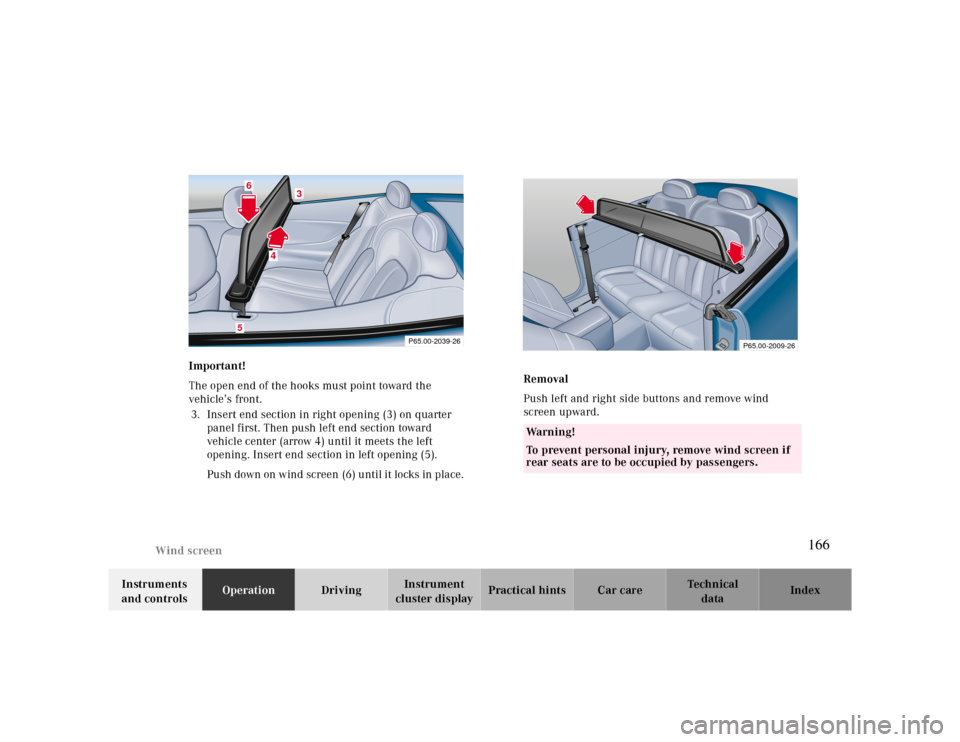
Wind screen
Te ch n ica l
data Instruments
and controlsOperationDrivingInstrument
cluster displayPractical hints Car care Index Important!
The open end of the hooks must point toward the
vehicle’s front.
3. Insert end section in right opening (3) on quarter
panel first. Then push left end section toward
vehicle center (arrow 4) until it meets the left
opening. Insert end section in left opening (5).
Pu sh down on w ind screen (6) u ntil it locks in pla ce.
P65.00-2039-26
3
4
56
Operation
Removal
Push left and right side buttons and remove wind
screen upward.
Wa r n i n g !
To prevent personal injury, remove wind screen if
rear seats are to be occupied by passengers.
P65.00-2009-26
166
Page 167 of 323
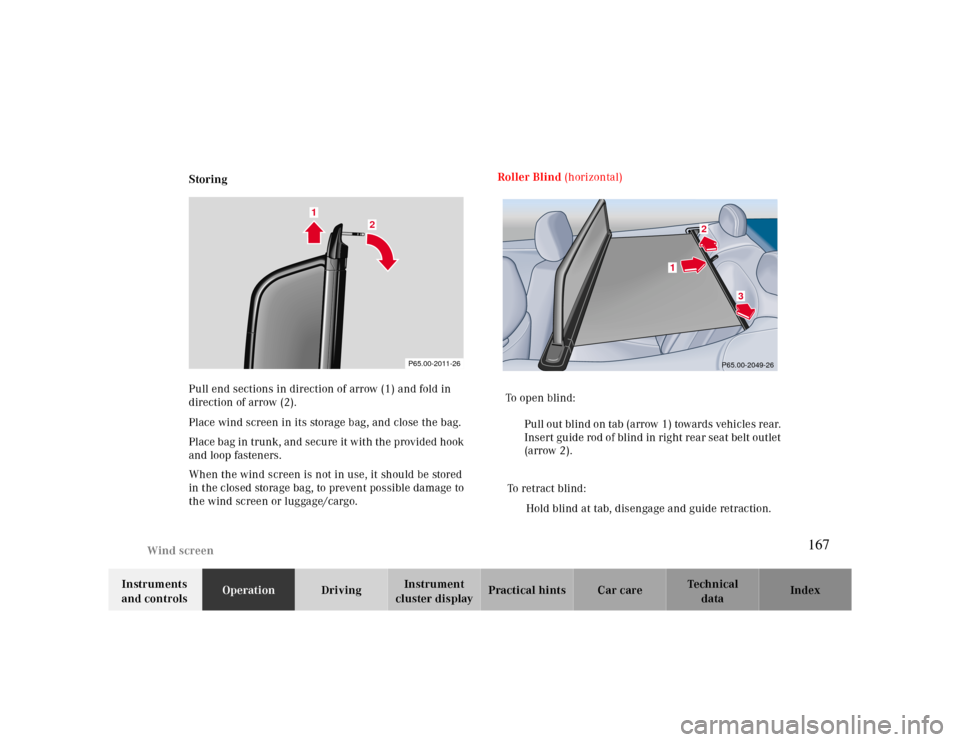
Wind screen
Te ch n ica l
data Instruments
and controlsOperationDrivingInstrument
cluster displayPractical hints Car care Index Storing
Pull end sections in direction of arrow (1) and fold in
direction of arrow (2).
Place wind screen in its storage bag, and close the bag.
Place bag in trunk, and secure it with the provided hook
and loop fasteners.
When the wind screen is not in use, it should be stored
in the closed storage bag, to prevent possible damage to
the wind screen or luggage/cargo.
P65.00-2011-26
1
2
Roller Blind (horizontal)
To open blind:
Pull out blind on tab (arrow 1) towards vehicles rear.
Insert guide rod of blind in right rear seat belt outlet
(arrow 2).
To retract blind:
Hold blind at tab, disengage and guide retraction.
3
1
2
P65.00-2049-26
167
Page 168 of 323
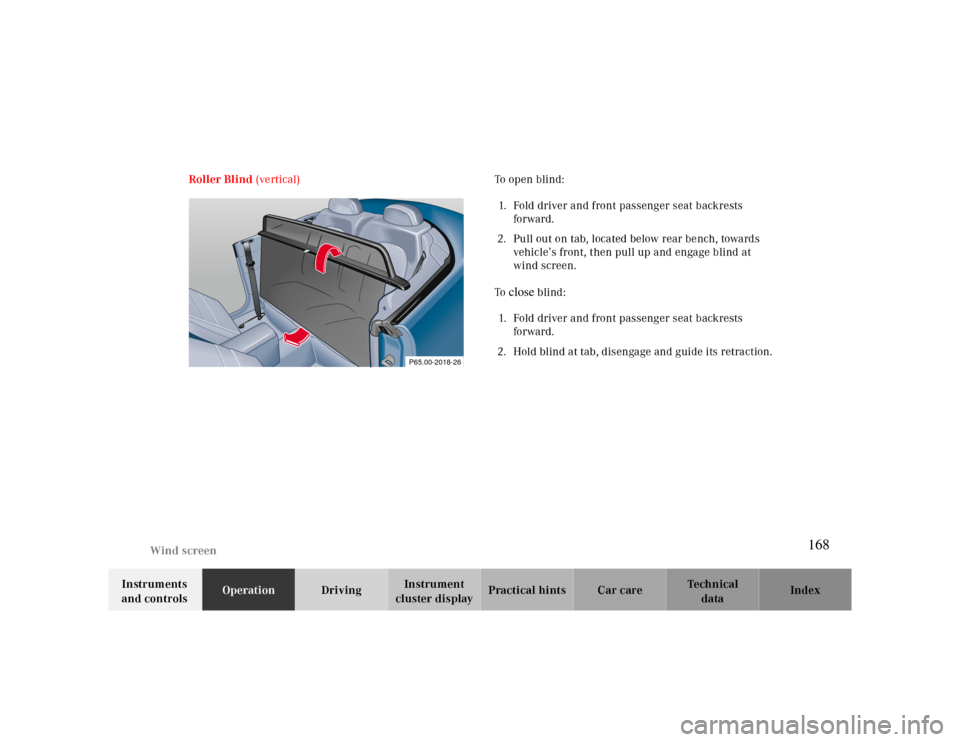
Wind screen
Te ch n ica l
data Instruments
and controlsOperationDrivingInstrument
cluster displayPractical hints Car care Index Roller Blind (vertical) To open blind:
1. Fold driver and front passenger seat backrests
forward.
2. Pull out on tab, located below rear bench, towards
vehicle’s front, then pull up and engage blind at
wind screen.
To
close
blind:
1. Fold driver and front passenger seat backrests
forward.
2. Hold blind at tab, disengage and guide its retraction.
P65.00-2018-26
168
Page 169 of 323

Driving
Parking 195
Tires 195
Control and operation of radio transmitters
170 Snow chains 198
The first 1 000 miles (1 500 km) 171 Winter driving instructions 198
Maintenance 171 Deep water 199
Catalytic converter 172 Passenger compartment 200
Emission control 173 Travelling abroad 200
Tele Aid 174 Cruise control 201
Steering lock 180 Brake assist system (BAS) 204
Starting and turning off the engine 182 Antilock brake system (ABS) 206
Automatic transmission 183
Electronic stability program (ESP)
208
Parking brake 192 What you should know at the gas station 211
Driving instructions 192 Check regularly and before a long trip 213
Drive sensibly – save fuel 192
Drinking and driving 193
Pedals 193
Power assistance 193
Brakes 193
Driving off 194
169
Page 170 of 323
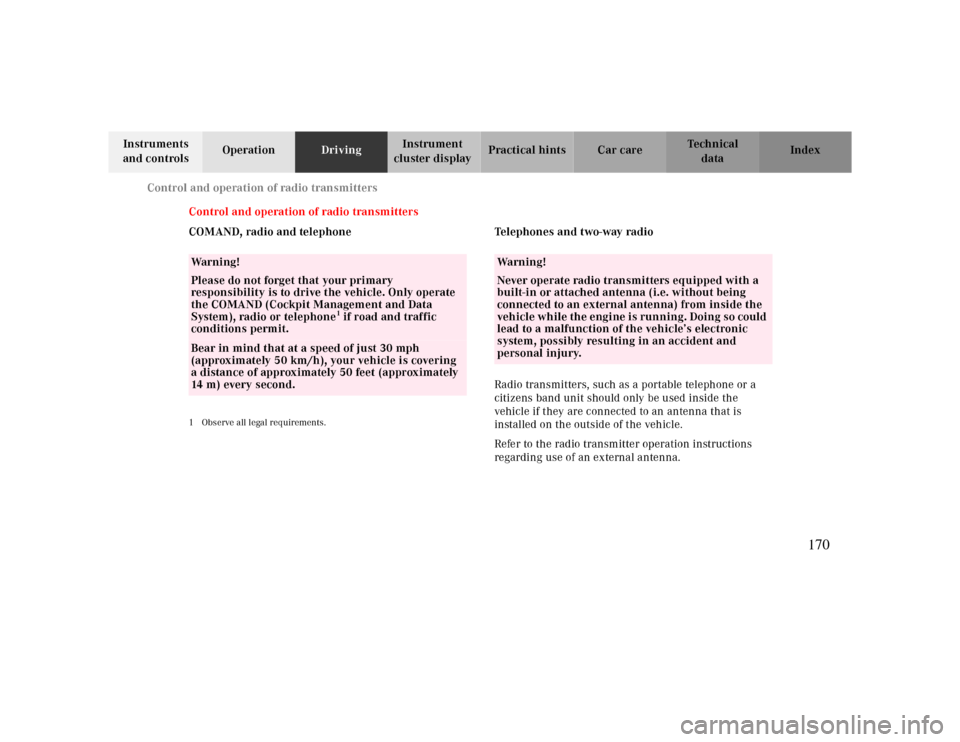
Control and operation of radio transmitters
Te ch n ica l
data Instruments
and controlsOperationDrivingInstrument
cluster displayPractical hints Car care Index
Control and operation of radio transmitters
COMAND, radio and telephone
1 Observe all legal requirements.
Telephones and two-way radio
Radio transmitters, such as a portable telephone or a
citizens band unit should only be used inside the
vehicle if they are connected to an antenna that is
installed on the outside of the vehicle.
Refer to the radio transmitter operation instructions
regarding use of an external antenna.
Warning!
Please do not forget that your primary
responsibility is to drive the vehicle. Only operate
the COMAND (Cockpit Management and Data
System), radio or telephone
1 if road and traffic
conditions permit.
Bear in mind that at a speed of just 30 mph
(approximately 50 km/h), your vehicle is covering
a distance of approximately 50 feet (approximately
14 m ) e ve r y s e c o n d .
Wa r n i n g !
Never operate radio transmitters equipped with a
built-in or attached antenna (i.e. without being
connected to an external antenna) from inside the
vehicle while the engine is running. Doing so could
lead to a malfunction of the vehicle’s electronic
system, possibly resulting in an accident and
personal injury.
170